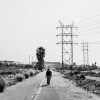Designing Open Space in the Bowtie to Reflect the L.A. River Today

Published in partnership with Clockshop, "South of Fletcher: Stories from the Bowtie" looks at Los Angeles’s greatest challenges and opportunities: the housing crisis, lack of open space, effects of climate change, and forces of urban development. This unassuming, seemingly abandoned site along the Los Angeles River pulls everything into focus. The future of the Bowtie Parcel, once one of Southern California’s most important railroad yards, is being discussed right now. "South of Fletcher: Stories from the Bowtie" aims to diversify the voices being heard by listening to the people who know the Bowtie — what it was, what it is, and who care about what it will become.

After the rail infrastructure of the old Taylor Yard was demolished, and before the Bowtie Parcel was bought by California State Parks, this 18-acre plot was headed toward a different destiny.
That was back in the late 1990s, when a local real estate development firm set its eyes on the parcel to house its new “LA Media Tech Center at Taylor Yard.”
“The railroad was decommissioning these rail yards, breaking these large maintenance yards into smaller parcels and then selling them off,” Sean Woods told us as he stood in the middle of the Bowtie one day this fall. Woods is the superintendent of California State Parks for the Los Angeles sector, which owns the Bowtie today. “And you can see just over to the left here, that there's this whole row of big-box development,” he said, pointing to some large warehouses on the other side of the train tracks, directly outside the lot.
That’s what the community saw then, and they became very alarmed. So alarmed, that they started protesting the planned LA Media Tech Center, posting yard signs that read “Warehouses? We don’t need no stinkin’ warehouses!” and “Give our kids a place to play.”
Around 1999, a group called Coalition for a State Park at Taylor Yard, which represented over 32 community organizations, went full-on against the developer and threatened litigation, successfully stopping development on the majority of the site.
Not only did the locals stop the big-box development, but their protest paved the way for the state acquisition of this land along the L.A. River in 2003 — an important piece of the long-term vision to make Los Angeles green.
“State Parks was grappling with what it wanted to look like in the 21st century,” Woods told us. ”We were looking at the fact that we had all these incredible pieces of property — 280 parks statewide. But by and large, people coming to those parks didn't represent the complexity of the state.”

In other words, California was a culturally- and racially-diverse state, but its natural beauty — its world-renowned parks like the Armstrong Redwoods State Natural Reserve and the Antelope Valley California Poppy Reserve — were not within reach to many people living within its cities. This was especially true for working-class black, Latino and immigrant families in Los Angeles.
A more equitable L.A. is possible in the future, but it will require residents of all backgrounds to demand what they need and to work toward those needs — whether that’s a revitalized river, more affordable housing, or more parks.
The Bowtie is many things at once. It’s one of the few remaining urban habitats for plants and animals like coyotes, rabbits, and the side-blotched lizard. It’s a train yard filled with ghosts from its past, decorated by new graffiti. It’s also a refuge for many — housed and homeless alike — who seek an escape from the stress and congestion of the city.

Harmonizing all these interests on a single 18-acre plot will be a huge design challenge. But this thrills Kat Superfisky, an urban ecologist and landscape designer, and part of the team that will help re-envision the Bowtie lot in years to come.
“We need to start rethinking how we’re seeing an amenity for a park space, where it’s not just a water fountain, it’s not just a restroom, it’s not just a trash can,” said Kat. “It’s, what else are we missing in this fabric of the urban ecosystem? And how can we start weaving that in innovative ways into these public spaces that people will have equal access to?”
Kat describes L.A. as a “come-one, come-all kind of a place,” where we do a great job of living amongst one another. But the next step for the Los Angeles area, she says, will be to figure out how our public spaces, including the Bowtie, can reflect that.
Top Image: Buildings just east of the Bowtie are occupied by media arts businesses and artists. Had a proposed development plan from the late-1990s succeeded, a much larger “LA Media Tech Center” would have transformed the former rail yard | Photo by Bear Guerra
More photos from this project are on view at Occidental’s Weingart Gallery through November 4, presented by Oxy Arts.
The South of Fletcher podcast is live now. New episodes are released bi-weekly on Clockshop and on Apple Podcasts.
















